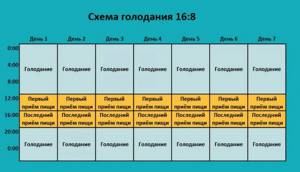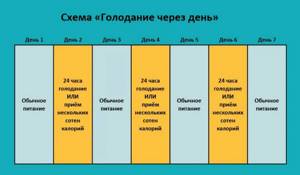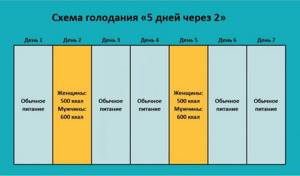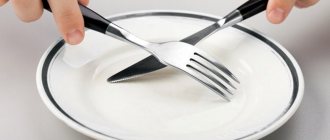If you want to get rid of excess weight and at the same time achieve good results in building a beautiful figure, try the technique of intermittent fasting for weight loss.
Experienced bodybuilders often say that you need to eat small meals, often, every day. For example, eat brown rice, chicken breast, cucumbers, greens with a small pinch of salt.
But, if you have the opportunity to eat at 2-hour intervals throughout the day, you can try a new approach to eating based on TEP.
TEP is the thermic effect of food, which means that with each meal your metabolism increases.
What is this approach and how does it work? TEP ensures that you always keep your metabolism at a certain level and increase it throughout the day.
This doesn't necessarily mean that this approach will solve all your problems (science is still studying this approach to determine whether eating small meals increases your metabolism that much), but it is a fact that there may be a small potential benefit from this approach.
All people are completely different depending on body weight, physical fitness, goals, etc. However, 5-6 meals a day is about the right number to get the maximum benefit if you want to lose weight and get a great body. The basis of this method is that you will feel hungry every couple of hours.
But what if there is another way that can guarantee the preservation of muscles, a decrease in body fat with an increase in strength and energy? You can use the technique of intermittent fasting. This method is especially good for those who want to lose weight without losing muscle.
Read about how to dry properly to preserve muscle mass.
What is intermittent fasting?
Intermittent fasting (IF) is a popular eating technique that allows you to cycle between meals and periods of fasting.
One of the most common methods is the so-called 16/8 method, which involves limiting your food intake for 16 hours with an eight-hour interval when you can snack.
What are the advantages of this method? Intermittent fasting is a fairly flexible approach from the point of view that you do not completely follow a diet and limit yourself in food, but you can eat whatever you want, only within a certain time frame.
Moreover, there is no need to constantly worry about the exact amount of protein you consume with each meal, since you do not always need to increase the rate of protein synthesis to grow muscle mass.
But won't this approach reduce muscle size?

Definitely not. Let's say your daily 8-hour eating window starts from 1 pm to 9 pm. The rest of the time, your body is in the so-called “hungry state”.
Throughout this period, you will be raising your anabolic hormone levels.
The eternal question: is water or dry fasting better for weight loss and health?
Both methods are used everywhere. For this reason, each species has its adherents. But which is better?
Practicing naturopathic doctor Mikhail Sovetov is a proponent of water fasting. He explains his point of view as follows:
“Without fluids, it is very difficult for the body to perform basic cleansing. Water has to be extracted from your own cells, destroying them. It is worth taking into account that some of them are a repository for toxins. By gaining access to blood, there is a risk of disrupting the functions of surrounding organs.”
Shchennikov Leonid Aleksandrovich (founder of the school of healing abstinence) holds the opposite opinion. He considers:
“Without access to liquid, the body switches to endogenesis (feeding on its own resources. The process of self-healing and regeneration is activated. The blood is purified, which is very difficult or impossible when drinking water."
Which fasting is best for weight loss? You, dear reader, will have to answer for yourself. I suggest you read reviews from people who are losing weight and what problems they have when not eating.

How does the method work?
Fasting decreases the level of leptin in the body, a hormone that suppresses hunger.
Eventually, your body responds by producing more testosterone, which decreases by 1% every year after you turn 30 (so it's definitely a beneficial effect for the body).
To summarize, testosterone levels are something that needs to be monitored and maintained.
However, the surprising fact is that along with the level of testosterone, the level of growth hormone in the body also increases. One study1 showed a 2000% increase in human growth hormone levels when certain fasting intervals were observed.
But this is not the only advantage; Fasting itself is much easier than constantly scheduling meals, which always leaves you stressed out waiting for the next meal.

How to fast properly to lose weight?
We mentioned earlier that fasting can significantly increase the levels of growth hormone in your body.
In fact, these are the most necessary hormones for any athlete, like a bodybuilder who lifts weights and subjects his body to enormous stress.
But don't forget that it is very important to eat in a way that matches your goals. Build your fasting method according to your needs.
However, the number of calories still matters, as does what you eat. But you can be a little more lenient with yourself and just make sure you're eating the exact number of calories you need in an eight-hour window.
If you plan to train during the fasting period (black coffee will help you here), then you will increase the effect of nutrient distribution in the body after training. What this generally means is that your body makes better use of the post-workout food it needs for energy, healthy fat, and improved excretion.
Since cyclic fasting forces the body to better utilize the food it eats, it will also improve the synthesis of new muscle fibers and replenish the body with the necessary energy, rather than storing fat.
This way you will always be slim and fit.
It's also worth remembering that if you're trying to lose weight and build muscle, regular fasting can be a very useful tool for you. But even if you want to build muscle, then 24-hour fasting intervals once or twice a week can also produce positive results.
Fasting schedule
The fasting technique is quite flexible, which is one of the main reasons for its popularity.
Basically, you can make intermittent fasting work for you, your environment, and your quality of life. As we mentioned earlier, this is one of the most common approaches, which involves simply skipping breakfast and eating no later than 8 pm.
The diagram of periods of feeding and fasting looks like this:
- From 1 pm to 9 pm we can eat
- From 9 pm to 1 pm fasting mode.
The flexibility of this approach depends not only on the length of time you can choose to eat, but also on the length of your fast. Some people choose to space out their meals at 6 hours to further extend the amount of time their body is in a fasting state. Ultimately, you can adjust the intervals and still achieve positive results.
If you have emotional disorders, you can try giving up food completely every two weeks.
However, even thinking about such a harsh approach sometimes makes you want to cry, so we won't do that. Prolonged fasting is not entirely suitable for bodybuilders, as they primarily need to maintain their muscle mass.
Alternatively, if you want to build muscle, you can try fasting for one day once a week. We know it sounds scary, but you actually don't need to eat as much as you think.
Everyone says that breakfast is “the most important meal of the day,” and nothing is more important than eating grains that provide energy to our bodies.
Do you think where the primitive people we worry about so much could get a bowl of porridge at 8 am, turkey breast and rice at 10 am, white fish and potatoes at 12 pm?
That's right, nowhere.
Psychologically, this type of fasting can really help break unhealthy beliefs about eating practices, as well as about appropriate meal times.
You don't need to eat all the time. You will still build muscle and control calories after each day of this technique.
Example:
- Sunday – Eat as usual
- Monday – Stop eating at lunchtime
- Tuesday – Start eating a full lunch
- Wednesday – Eat as usual
This approach can really help with maintaining proper hormone levels in the body, while at the same time reducing the number of calories consumed earlier in the week. Therefore, you can still easily catch up over the next few days to accelerate muscle growth.

Intermittent fasting chart for a week
Losing weight by fasting
The subcutaneous dense fat layer covering the organs, as well as accumulated waste and toxins, has a negative impact on a person’s performance, takes away energy and worsens health. As a result, increased fatigue, shortness of breath, chronic fatigue, and psycho-emotional and physiological diseases appear. Fasting is a biological process that promotes complete cleansing of the body and helps activate protective functions.
Correct periodic refusal of food helps to normalize the functioning of all organs, which leads to rejuvenation of the body, effective weight loss, and overall health . The advantage of such a system over a diet is that it quickly relieves a person of excess weight, while eliminating the causes of its occurrence. In addition, the advantages of this method are:
- a person tolerates it more easily;
- Safe and rapid weight loss occurs;
- getting rid of extra pounds is accompanied by an improvement in overall well-being and a healthier body.
Methodology
Fasting for weight loss is an effective quick way to lose excess weight, improve your health and strengthen your body. The essence of this technique is to voluntarily refuse food for a certain time. Fasting is the absence of calorie intake. During this process, the body first eats stored glycogen located in the muscles and liver. By breaking down, this polysaccharide maintains optimal glucose levels. With this system, glycogen can last for 2 days.
Giving up food to lose weight is difficult. However, fasting can indeed significantly reduce body weight. After all, with this process, fat reserves accumulated over the years are quickly consumed. Weight loss before the onset of a hypoglycemic crisis reaches approximately 2 kg per day, further reduction slows down slightly - up to 300 g per day. An approximate weight loss plan for different periods:
- one-day – minus 3 kg;
- three-day – 5 kg;
- ten days - 7 kg;
- medium term (14 days) – 10 kg;
- more than two weeks - approximately 1 kg in 3 days.

A good result can be obtained by using fasting for medium-term weight loss in combination with properly selected restorative nutrition. This period helps to turn on deep cleansing mechanisms. Before practice, you should visit a doctor, carry out cleansing procedures, and start the process from one day, only after that you can gradually increase the period of abstaining from food.
Advantages and disadvantages
Hunger for weight loss plays an important role, but often the lack of food causes severe malaise and discomfort in a person. This is a kind of protection for the body; these symptoms quickly disappear if the technique is carried out correctly. The benefit of such a system is that the following therapeutic effects begin to occur in the body, which is free from digestion of food:
- skin condition improves (acne, spider veins disappear);
- all organs and tissues are healed and cleansed;
- lightness appears in the body, weight decreases;
- bloating, flatulence, and a feeling of fullness in the stomach disappear;
- the load on the liver and kidneys is reduced;
- nails and hair are strengthened.
Long-term abstinence from food helps cure chronic illnesses. An even greater advantage of fasting for weight loss is that with significant weight loss, a person does not have sagging skin, which is characteristic of diets. It should be borne in mind that only correct implementation of the technique, which is carried out in compliance with the recommendations and only after consulting a specialist, can be beneficial . Indeed, during a long period of incorrect refusal of food, a person does not receive enough nutrients, the deficiency of which harms the body, as a result of:
- appearance deteriorates - hair becomes brittle, skin begins to peel;
- headache and weakness appear;
- resistance decreases, immunity weakens, colds do not heal for a long time;
- stomach problems appear.
Contraindications
You should not start losing weight while fasting without first consulting your doctor. In case of serious heart disease or chronic diseases, in order not to harm the body, it is necessary to lose weight only in specialized medical institutions under the supervision of experienced specialists. In addition, people who have the following health problems should not adhere to such a system:
- diabetes;
- kidney and stomach diseases (ulcers, gastritis);
- exhaustion of the body;
- tuberculosis;
- nervous system disorders;
- oncology;
- cirrhosis.

What other benefits do intermittent fasting have?
The main benefit is that fasting stimulates the production of vital hormones and reduces calorie intake (don't be alarmed, but it is better to eat this way than eat small portions more than 6 times every day).
But there are also a number of other advantages:
- You can extend your life
According to one study, alternating periods of fasting and eating allowed people to live longer lives. This is most likely due to the fact that when you are in starvation mode, your body finds other sources and reserves to extend its life.
- Reduces the risk of developing cancer
Although there is no real medical evidence behind this claim, one extensive study3 (based on the results of many scientific papers) showed that this technique can help reduce the risk of developing cancer and cardiovascular diseases.
Contraindications
Therapeutic abstinence from food is not recommended to be used thoughtlessly. Before using any form of fasting, consult your doctor! Improper use of one or another technique can lead to irreparable consequences. We do not take any responsibility for your actions.
From the standpoint of modern medicine, it is prohibited to use water fasting methods for people who have:
- severe underweight
- bright processes of inflammation
- liver cirrhosis, hepatitis
- malignant cancer tumors
- heart muscle beating disorder
- serious blood clots
- chronic kidney disease
You should also abstain in the first months after a myocardial infarction or stroke. Always soberly assess your health and do not neglect contraindications.

Which fasting technique is right for you?
Intermittent fasting (IF) is a fairly popular eating technique that allows you to cycle between meals and periods of fasting. As you probably already understood, this is not exactly a diet, but rather a way to regulate the number of calories you consume from food by controlling the intervals between meals. Below you will learn how to fast properly to lose weight using one of the following methods.

Losing weight is the main reason men try the fasting-eating technique4. There are claims that short-term fasting helps speed up metabolism by 3.6-14% 5 6, which helps burn excess calories and lose weight. However, many people use this technique to potentially protect the body from disease, as well as to increase life expectancy. Followers of intermittent fasting usually do not count calories, but simply eat healthy foods rich in beneficial micro and macro elements.
As this approach to nutrition has become increasingly popular, many variations of this technique have emerged in recent years. Which one is right for you and your lifestyle?
Let's find out. Below are the most popular intermittent fasting methods and how they fit into your daily life.
Scheme 16/8

Best suited for those who do not feel hungry in the morning.
How does he work?
The 16/8 method involves restricting food intake at eight-hour intervals. Typically this time is before noon and 8 pm. The advantage of this method is that you do not need to limit yourself to consuming a certain number of calories. As long as you eat healthy foods within the eight-hour window, you shouldn't gain excess weight.
You can also choose an eight-hour interval according to your specific needs. If you don’t feel hungry in the morning, then the 16/8 diet will work for you, since you won’t be tempted to touch food until lunch. In addition, this method does not limit you to drinking water, tea or coffee. Don't forget that water helps increase your feeling of fullness.
Intermittent or alternate day fasting

Best suited for those who prefer to eat only healthy foods.
How does it work?
This fasting method is one of the most popular PG regimens due to its ability to stimulate human metabolism. When you shorten your eating window, you create a fasting window during which your body functions using its own previously stored glycogen from carbohydrates and fats as fuel.
Intermittent fasting means that you fast every other day. For example, you can limit your calorie intake to 500 on fasting days and then return to your normal diet the next day. If you are already on a strict diet and are used to eating less than usual, then this method will work great for you.
You can even go further and completely restrict yourself from eating for large intervals, for example, 24 hours.
Warrior Diet

Best suited for those who prefer to eat in the evening.
The essence of the method
Based on the eating patterns of our ancient ancestors, the warrior diet means that you eat small amounts of food during the day, but in the evening or towards night you start to feast. Every day for 20 hours you limit yourself to food and eat small portions, eating mainly fresh fruits and vegetables, fresh juices and hard-boiled eggs.
And after these 20 hours, in a 4-hour interval, you can eat almost any food that we have been dreaming about all day. Ideal if you save a big meal until later in the day.
Eating at night is thought to increase the parasympathetic nervous system's ability to help the body fully recover, providing a feeling of calm and relaxation while also aiding the digestive process. This method also helps the body produce necessary hormones and promotes fat burning throughout the day. Eating one meal a day has been proven to reduce fat mass and promote muscle growth7.
Scheme 5/2

Best suited for those who want to maintain muscle mass.
The essence of the method
Similar to intermittent fasting, the 5/2 method involves eating as usual for five days a week and consuming about 25% of your usual calories for the remaining two days. This means that at least two days a week you eat about 500-600 calories.
Using this technique, you need to count the calories you consume. Many men prefer the 5/2 diet over others because it helps maintain muscle mass in an amazing way. You're not in a constant calorie deficit, but you allow your body to use body fat as fuel two days a week to help you lose weight. This method is highly effective for weight loss and improving insulin sensitivity8.
What kind of mechanism is this - hunger with the help of water?
Water fasting is one of the popular ways to abstain from food. With this approach, only water is allowed.
When the supply of nutrients is limited or completely absent, the body begins to cleanse itself. Subcutaneous fat is broken down and used as fuel to maintain life.
Read more about losing weight with water in my article here.

In addition to losing weight, abstaining from food has the following positive effects:
- comprehensive rejuvenation through cell regeneration
- strengthening the immune system due to stress on the body
- destruction of pathogenic bacteria due to complex alkalization
Drinking enough water makes the process easier. The kidneys are involved in the work, through which most pathogenic substances are eliminated.

For whom is PG not suitable?
Intermittent fasting is considered one of the safest methods for losing weight, especially for healthy adults who eat properly. However, this method is not suitable for everyone.
Some people should avoid dietary restrictions and fasting methods completely. These include:
- People who regularly experience a drop in blood sugar levels.
- If you frequently experience eating disorders.
- Persons with type 1 diabetes mellitus.
- If you are underweight or have nutritional deficiencies.
Also remember that any overeating during your meals can undo any progress made during the fast.
There is actually no specific method that is necessarily better than others. It all comes down to personal preference. If you have a medical condition, you should first consult your doctor before trying fasting for weight loss.











